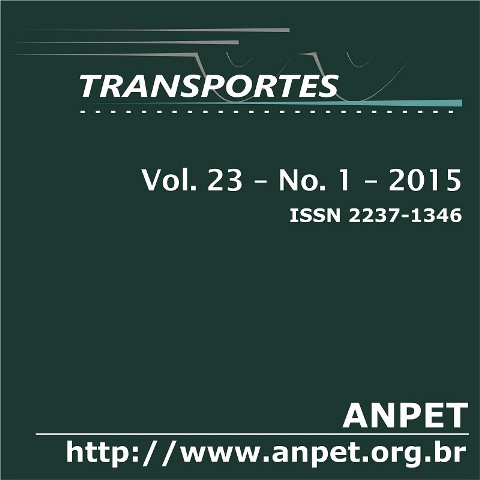Planejamento de atracação de navios por meio de um modelo matemático para o problema de alocação de berços contínuos com descontinuidade do cais
DOI:
https://doi.org/10.14295/transportes.v23i1.861Keywords:
Continuous Berth Allocation Problem with Berth Discontinuities, Port Operation. Mixed Integer Linear Programming.Abstract
Brazilian ports handle 927 million tons of cargo/year representing 94% of exports. This paper presents a mathematical model that aims to contribute to the planning of berthing of ships in ports, especially those that have the characteristic of having discontinuities along the wharf or caused by expansion of a passage that was wider than the rest or the port has two margins. The proposed model was called the Continuous Berth Allocation Problem with Discontinuity of Pier (PABC-DC) and was applied in the public terminals at the Port of Vitória (Victory Commercial Wharf and Terminal CODESA). The model was solved in CPLEX 12.6 with real data of Port of Vitória. The model results compared with the results of manual planning done by the port always showed always a reduction in the total time that the ships spent at the port, reaching up 8.7% reduction.Downloads
References
ANTAQ (2013) Boletim Portuário 1º Semestre 2013. Agência Nacional de Transportes Aquaviários.
Bierwirth, C.; Meisel, F. (2009) A fast heuristic for quay crane scheduling with interference constraints. Journal of Scheduling, v. 12, n. 4, p. 345–360. DOI: 10.1007/s10951-009-0105-0
Bierwirth, C.; F. Meisel (2010) A survey of berth allocation and quay crane scheduling problems in container terminals. European Journal of Operational Research, v. 202, n. 3, p. 615– 627. DOI: 10.1016/j.ejor.2009.05.031
Briano, C.; Briano, E.; Bruzzone, A.G. (2005) Models for support maritime logistics: a case study for improving terminal planning. In: Merkuryev, Y., Zobel, R., Kerckhoffs, E. (eds.) Proceedings of the 19th European Conference on Modeling and Simulation (ECMS). p. 199–203.
Brown, G.G.; Cormican, K.J.; Lawphongpanich, S.; Widdis, D. (1997) Optimizing submarine berthing with a persistence incen-tive. Naval Research Logistics, v. 44, n. 4, p. 301–318. DOI: 10.1002/(SICI)1520-6750(199706)44:4<301::AID-AV2>3.0.CO; 2-A
Brown, G.G.; Lawphongpanich, S.; Thurman, K.P. (1994) Opti-mizing ship berthing. Naval Research Logistics, v. 41, n. 1, p. 1–15. DOI: 10.1002/1520-6750(199402)41:1<1::AIDNAV3220410102>3.0.CO;2-L
Chang, D.; Yan, W.; Chen, C.-H.; Jiang, Z. (2008) A berth allo-cation strategy using heuristics algorithm and simulation optimi-zation. International Journal of Computer Applications in Tech-nology, v. 32, n. 4, p. 272–281. DOI: 10.1504/IJCAT.2008.021382
Chen, C.-Y.; Hsieh, T.-W. (1999) A time-space network model for the berth allocation problem. In: 19th IFIP TC7 Conference on System Modeling and Optimization, Cambridge, England, p. 12–16.
Cheong, C.; Tan, K.; Liu, D.; Lin, C. (2010) Multi-objective and prioritized berth allocation in container ports. Annals of Operations Research, v. 180, n. 1, p. 63–103. DOI: 10.1007/s10479-0080493-0
Cheong, C.Y.; Lin, C.J.; Tan, K.C.; Liu, D.K. (2007) A multi-objective evolutionary algorithm for berth allocation in a container port. In: Congress on Evolutionary Computation 2007 (CEC 2007). IEEE, Singapore, p. 927–934. DOI: 10.1109/CEC.2007.4424569
CODESA. (2014a) Complexo Portuário. Companhia Docas do Espírito Santo. Disponível em: http://www.CODESA.gov.br/site/OPorto/ComplexoPortu%C3%A1rio/tabid/77/l
anguage/pt-BR/Default.aspx. Acesso em 05/03/2014.
CODESA. (2014b) Anuário Estatístico de 2013. Companhia Docas do Espírito Santo. Disponível em: http://www.vitoria
port.com.br/Site/LinkClick.aspx?fileticket=piEIiUcsB8%3D&tabid=665&mid=1589&language=pt-BR. Acesso em 10/05/2014.
Cordeau, J.-F.; Laporte, G.; Legato, P.; Moccia, L. (2005) Models and tabu search heuristics for the berth-allocation problem. Transportation Science, v. 39, n. 4, p. 526–538. DOI: 10.1287/trsc.1050.0120
Dai, J.; Lin, W.; Moorthy, R.; Teo, C.-P. (2008) Berth allocation planning optimization in container terminals. In: Tang, C.S.; Teo, C.-P.; Wei, K.-K. (eds.) Supply chain analysis: a handbook on the interaction of information, System and Optimization. Springer, New York, p. 69–105. DOI: 10.1007/978-0-387-75240-2_4
Elwany, M. H.; Ali, I.; Abouelseoud, Y. (2013) A heuristics-based solution to the continuous berth allocation and crane as-signment problem. Alexandria Engineering Journal, v. 52, n. 4, p. 671–677. DOI: 10.1016/j.aej.2013.09.001
Ganji, S. R. S.; Babazadeh, A; Arabshahi, N. (2010) Analysis of the continuous berth allocation problem in container ports using a genetic algorithm. Journal of marine science and technology, v. 15, n. 4, p. 408–416. DOI: 10.1007/s00773-010-0095-9
Garey, M.R.; Johnson, D.S. (1979) Computers and intractability: a guide to the theory of np-completeness. WH Freeman, San Francisco, USA.
Goh, K.S.; Lim, A. (2000) Combining various algorithms to solve the ship berthing problem. In: Proceedings of the 12th International Conference on Tools with Artificial Intelligence (ICTAI’00). IEEE, Vancouver, BC, p. 370–375. DOI: 10.1109/TAI.2000.889896
Guan, Y.; Cheung, R.K. (2004) The berth allocation problem: models and solution methods. OR Spectrum, v. 26, n. 1, p.75–92. DOI: 10.1007/s00291-003-0140-8
Guan, Y.; Xiao, W.-Q.; Cheung, R.K.; Li, C.-L. (2002) A multi-processor task scheduling model for berth allocation: heuristic and worst-case analysis. Operations Research Letters, v. 30, n. 5, p. 343–350. DOI: 10.1016/S0167-6377(02)00147-5
Imai, A.; Nishimura, E.; Hattori, M.; Papadimitriou, S. (2007) Berth allocation at indented berths for mega-containerships. European Journal of Operational Research, v. 179, n. 2, p. 579–593. DOI: 10.1016/j.ejor.2006.03.034
Imai, A.; Nishimura, E.; Papadimitriou, S. (2001) The dynamic berth allocation problem for a container port. Transportation Research Part B: Methodological, v. 35, n. 4, p. 401–417. DOI: 10.1016/S0191-2615(99)00057-0
Imai, A.; Sun, X.; Nishimura, E.; Papadimitriou, S. (2005) Berth allocation in a container port: using a continuous location space approach. Transportation Research Part B: Methodological, v. 39, n. 3, p. 199–221. DOI: 10.1016/j.trb.2004.04.004
Kim, K.H.; Moon, K.C. (2003) Berth scheduling by simulated annealing. Transportation Research Part B: Methodological, v. 37, n. 6, p. 541–560. DOI: 10.1016/S0191-2615(02)00027-9
Kim, K. H.; Park, Y. M. (2004) A crane scheduling method for port container terminals. European Journal of Operational Re-search, v. 156, n. 3, p. 752–768. DOI: 10.1016/S0377-2217(03)00133-4
Lee, Y.; Chen, C.-Y. (2008) An optimization heuristic for the berth scheduling problem. European Journal of Operational Research, v. 196, n. 2, p. 500–508. DOI: 10.1016/j.ejor.2008.03.021
Li, C.-L.; Cai, X.; Lee, C.-Y. (1998) Scheduling with multiple-job-on-one-processor pattern. IIE Transactions, v. 30, n. 5, p. 433–445. DOI: 10.1023/A:1026487022192
Lim, A. (1998) The berth planning problem. Operations Research Letters, v. 22, n. 2, p. 105–110. DOI: 10.1016/S0167
(98)00010-8
Lim, A. (1999) An effective ship berthing algorithm. In: Thomas, D. (ed.) Proceedings of the 16th International Joint Conference on Artificial Intelligence (IJCAI-99-vol-1). Morgan Kaufmann Publishers, San Francisco, p. 594–599.
Meersmans, P.J.M.; Dekker, R. (2001) Operations research supports container handling. Econometric Institute Research Papers, v. 234.
Moon, K. (2000) A mathematical model and a heuristic algorithm for berth planning. Brain Korea, v. 21.
Moorthy, R.; Teo, C.-P. (2006) Berth management in container terminal: the template design problem. OR Spectrum, v. 28, n. 4, p. 495–518. DOI: 10.1007/978-3-540-49550-5_4
Nishimura, E.; Imai, A.; Papadimitriou, S. (2001) Berth allocation planning in the public berth system by genetic algorithms. European Journal of Operational Research, v. 131, n. 2, p. 282–292. DOI: 10.1016/S0377-2217(00)00128-4
Park, K.T.; Kim, K.H. (2002) Berth scheduling for container terminals by using a sub-gradient optimization technique. Journal of the Operational Research Society, v. 53, n. 9, p. 1054–1062. DOI:
1057/palgrave.jors.2601412
Park, Y.M.; Kim, K.H. (2003) A scheduling method for berth and quay cranes. OR Spectrum, v. 25, n. 1, p. 1–23. DOI: 10.1007/s00291-002-0109-z
Rashidi, H.; Tsang, E. (2013) Novel constraints satisfaction models for optimization problems in container terminals. Applied Mathematical Modelling, v. 37, n. 6, p. 3601–3634. DOI: 10.1016/j.apm.2012.07.042
Stahlbock, R.; Voß, S. (2008) Operations research at container terminals: a literature update. OR Spectrum, v. 30, n. 1, p. 1–52. DOI: 10.1007/s00291-007-0100-9
Steenken, D.; Voß, S.; Stahlbock, R. (2004) Container terminal operation and operations research – a classification and literature review. OR Spectrum, v. 26, n. 1, p. 3–49. DOI: 10.1007/s00291003-0157-z
Tang, L.; Lia, S.; Liub, J. (2009) Dynamically scheduling ships to multiple continuous berth spaces in an iron and steel complex. International Transactions in Operational Research, v. 16, n. 1, p. 87–107. DOI: 10.1111/j.1475-3995.2009.00662.x
Tong, C.J.; Lau, H.C.; Lim, A. (1999) Ant colony optimization for the ship berthing problems. In: Thiagarajan, P.S.; Yap, R. (eds.) Advances in Computing Science – ASIAN’99: Fifth Asian Computing Science Conference, v. 1742 of LNCS. Springer Berlin Heidelberg, p. 359–370. DOI: 10.1007/3-540-46674-6_30
Umang, N.; Bierlaire, M. (2012) Real Time Recovery in Berth Allocation Problem in Bulk Ports. In: Proceedings of the Swiss Transport Research Conference (STRC).
Umang, N.; Bierlaire, M.; Vacca, I. (2013) Exact and heuristic methods to solve the berth allocation problem in bulk ports. Transportation Research Part E: Logistics and Transportation Review, v. 54, p. 14–31. DOI: 10.1016/j.tre.2013.03.003
Vacca, I.; Bierlaire, M.; Salani, M. (2007) Optimization at con-tainer terminals: Status, trends and perspectives. In: Proceedings of the Swiss Transport Research Conference (STRC), p. 1–21.
Vis, I.F.A. ; Koster, R. de (2003) Transshipment of containers at a container terminal: an overview. European Journal of Operational Research, v. 147, n. 1, p. 1–16. DOI: 10.1016/S03772217(02)00293-X
Wang, F.; Lim, A. (2007) A stochastic beam search for the berth allocation problem. Decision Support Systems, v. 42, n. 4, p. 2186–2196. DOI: 10.1016/j.dss.2006.06.008.
Downloads
Published
How to Cite
Issue
Section
License
Authors who submit papers for publication by TRANSPORTES agree to the following terms:
- Authors retain copyright and grant TRANSPORTES the right of first publication with the work simultaneously licensed under a Creative Commons Attribution License that allows others to share the work with an acknowledgement of the work's authorship and initial publication in this journal.
- Authors may enter into separate, additional contractual arrangements for the non-exclusive distribution of this journal's published version of the work (e.g., post it to an institutional repository or publish it in a book), with an acknowledgement of its initial publication in TRANSPORTES.
- Authors are allowed and encouraged to post their work online (e.g., in institutional repositories or on their website) after publication of the article. Authors are encouraged to use links to TRANSPORTES (e.g., DOIs or direct links) when posting the article online, as TRANSPORTES is freely available to all readers.
- Authors have secured all necessary clearances and written permissions to published the work and grant copyright under the terms of this agreement. Furthermore, the authors assume full responsibility for any copyright infringements related to the article, exonerating ANPET and TRANSPORTES of any responsibility regarding copyright infringement.
- Authors assume full responsibility for the contents of the article submitted for review, including all necessary clearances for divulgation of data and results, exonerating ANPET and TRANSPORTES of any responsibility regarding to this aspect.









